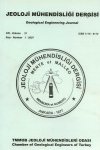
ABSTRACT: The study is executed in a wide area of the around Kayseri. Basalts are prevalent in northwestand southeast of this area, and are produced in the surroundings of Erkilet. The aim of this study isthe determination of production as building stone, depending on its geological setting,mineralogical and petrological properties, geochemistry, and technological testes of the basalt.Erkilet Basalt is the unit which belong to Miocene-Quaternary aged volcanites in the area.Mineralogically Erkilet Basalt contains 40-42 % microlites of plagioclase, 20-25 % clinopyroxene,18-20 % olivine, 4-5 % phenocrystales of plagioclase, 3-5 % orthopyroxene, calcite less than 4 %,opague mineral less than 4 %, and these basalts which indicate holocrystalline and porphyritictextures have composition of pyroxene-basalt. Geochemically, these rocks conform thoelitic-alkalicomposition according to distribution of K O-SiO , basalt according to distribution of (K O+Na O)-SiO , sub-alkali basalt according to distribution of Zr/TiO -Nb/Y, intracontinental basalt accordingto distribution of (Zr/Y)-Zr, and composition of continental basalt of late-post orogenic beltindicating effects of continental crust. Density, unit weight, rate of water suction in point of weight, pressure resistance, pressure resistance after than frost, frost loss and pressure resistance of thisrock appropriate for using being both natural building stone and coating stone. Plate giving, cuttingof edge-corner, and varnish taking of this rock is at good degree. Average abrasion resistance of thatis very near to the limit value.
ABSTRACT: The study area is located in the Orta-Şabanözü (Çankırı) region. Various rock units of Triassicto Quaternary crop out. Triassic unit in the area is Kösrelik formation, the Cretaceous unit is Eldivanophiolite. The Miocene rock units are Kurtsivrisi volcanics, Hançili formation, Karakoçaşformation, Hüyükköy formation, Eregez agglomerate and Aydos basalts. Pliocene rocks in the areaare represented by Orta formation and Büyükyakalı formation. Alluvium is formed in Quaternary.Of Tertiary units, Eregez agglomerate, Hançili formation and Orta formation contain coal.It is considered that formation of the basin is associated with northward subduction of NeoTethys ocean under both Sakarya continent and itself since the beginning of Late Cretaceous. Thereare various comments on the Neogene evolution of Çankırı basin resulting from variousobservations. In the area between Orta and Şabanözü (Çankırı) coalification is within Miocene andPliocene deposits. Although lignites of Pliocene Orta formation show a regular extent, they areoccured in a specified part of the basin. Lignite formations within Miocene deposits have no regularand continous extent. Lignite formations, generally observed within the unit differentiated as Eregezagglomerate in NW of the basin and within Hançili formation in SE of the basin, are notdifferantiated clearly owing to the interference of Miocene deposits.
ABSTRACT: The purpose of this investigation is to explain some neotectonic and paleoseismolojicalfeatures of Fethiye-Burdur Fault zone that is located in SW- Turkey between gulf of Fethiye andBurdur Lake. This zone, which is about 300 km. in length, is characterized as a combination of anumber of normal faults which has generally left lateral oblique-slip in feature. It is, also,charecterized as beeing the most active fault system in Southwest Anotolia. Burdur fault zone,normally, extends in NE-SW direction, but it was segmented in various lengths by several faultstilted in NW direction. Burdur and Tefenni segments, that are 60-70 km. in length, are considered asthe most active lines of these segments. It has been reported that two major earthquakes in 1914 and1971 took place on these segments with a magnitude of 7.1 and 6.2, respectively.Trench studies have been conducted on Yassıgüme and Burdur locations to investigatedeformations caused by the vertical displacements following the 1914 and 1971 earthquakes. TheBurdur fault in theYassıgüme location is characterized as a single line fault structure in the field. Itsvisible fault plane clearly reflects the left lateral oblique slip moving and related sliding lines. As aresult of the trench study performed on this segment a vertical displacement of 70 cm. in length hasbeen identified as belong the 1971 earthquake.On the other hand, Burdur segment, which is one of the most important branch of Burdur faultzone, consists of four different stepwise oblique fault systems within the south of Burdur Lake whichextends in NE direction. These fault systems pass through the city center of Burdur and caused thestepwise topographical features. The unconsolidated sediments within the trench section consistsdominantly of cross-bedded sands, mudstones and present slope-debris deposits. Also, fault planeand kolluvial sediments with muddy dike structures were found as most important structuralconstituents in the trenches. These structures are thought to be developed as a result of 1914earthquake. Several faults located on the hills show vertical displacements of 90-250 cm. Thesefaults are seen in discordant with the colluvial developments. Thus, the youngest faults located in thetrenches and hills can be considered having the highest vertical displacements. Observations ofsome folds and local discontinuties can be considered as typical in this type of settings.Two recent earthquekes, which took place in 3 and 5 April, 2002 with a magnitude of 3,9 and4,0 respectively, can be considered significant since they highlight the exsistence of sismic activityon this segment. Futhermore, they help us to prove that this segment can be identified as obliquelyleft tilted normal fault
ABSTRACT: For this study; different colored pyroclastics belong to Kavak ignimbrite that widely spreadsaround Nevşehir were choosen. These rocks were widely used as building stone in low storeyedbuildings and especially in historical building in the past. Nowadays, they have an increasing usagein outer surface covering of the buildings, stairs, floorings, banisters, pools and their surroundings,arches, columns, fireplaces, balcony decorations and restoration applications because of havingdecorative properties. Sampling was carried out in 6 different areas in the field because they havedifferent color and texture characteristics that change frequently in close areas. At firstpetrographical and chemical properties of these samples were determined and then standard rockmechanic experiments were carried out in order to determine their geomechanical properties.According to the results, it is exposed that investigated pyroclastics are non-welded ignimbrite andthere are important relationships between their geological, chemical, petrographical properties andgeomechanical properties. Especially, the samples having opaque minerals, fine grained rockfragments and higher matrix ratio than grain ratio, have lower porosity and higher density andcompressive strength.

 TMMOB
TMMOB